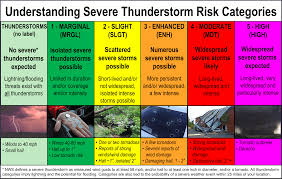The Unpredictable Forces of Nature
Severe thunderstorm warnings are more than just alerts on our smartphones or announcements on the evening news—they represent a looming threat that can turn serene afternoons into chaotic and dangerous situations. Every summer, Canadians brace themselves as dark clouds gather on the horizon, marking the onset of a storm season that can wreak havoc across provinces.
Understanding the Warning System
A severe thunderstorm warning occurs when the conditions for severe thunderstorms are likely to take shape. These storms can produce damaging winds, heavy rain, and even tornadoes. According to Environment Canada, severe thunderstorms are a frequent occurrence during the warmer months with over 150 such warnings issued across the country in the summer of 2023 alone.
“The unpredictability of severe weather can add significant stress to daily life, especially for families with children or elderly members,” shares meteorologist Sarah Chen. “Understanding these warnings and preparing ahead can save lives.”
Community Preparedness and Response
In light of the powerful capabilities of these storms, many communities have become proactive in their response. Local disaster preparedness programs are emerging as safety nets for residents facing the uncertain wrath of nature. Community centers often organize workshops to educate families on storm preparedness, emphasizing what to stock in an emergency kit or how to reinforce homes against high winds.
Social media has also played a pivotal role in how information about severe thunderstorm warnings is disseminated among the populace. Twitter threads and Facebook groups dedicated to weather updates have flourished, where users share live updates, safety tips, and personal experiences during storms. A recent survey revealed that 67% of Canadians rely on social media as their primary source for weather-related information.
Human Stories Behind the Alerts
The impact of these warnings stretches beyond mere statistics and safety guidelines. Behind every alert lies human stories of resilience, loss, and community spirit. During a severe thunderstorm that struck southern Ontario in July, many residents shared their experiences on social media. One user tweeted, “We hunkered down in the basement with our pets, listening to the howling winds—never felt so scared and so grateful at the same time.”
Such sentiments resonate in many communities, as individuals band together during these rocky times, fostering a sense of unity heightened by shared vulnerability. Neighbors check in on each other, offering support and supplies, reinforcing the idea that in the face of nature’s unpredictability, human connection remains a powerful force.
Looking Ahead
As climate change continues to alter weather patterns, experts warn that severe thunderstorms may become even more intense and frequent. This year alone, Canada has seen a more than 30% increase in severe weather alerts compared to the previous year. The pressing question for Canadians now is how to adapt and prepare for a future where storms are a constant reality.
Communities across the nation must not only heed the warnings but also take actionable steps towards preparedness. Through continuous education and shared experiences, Canadians can build resilience against the storms that threaten their safety and sanctuary.
